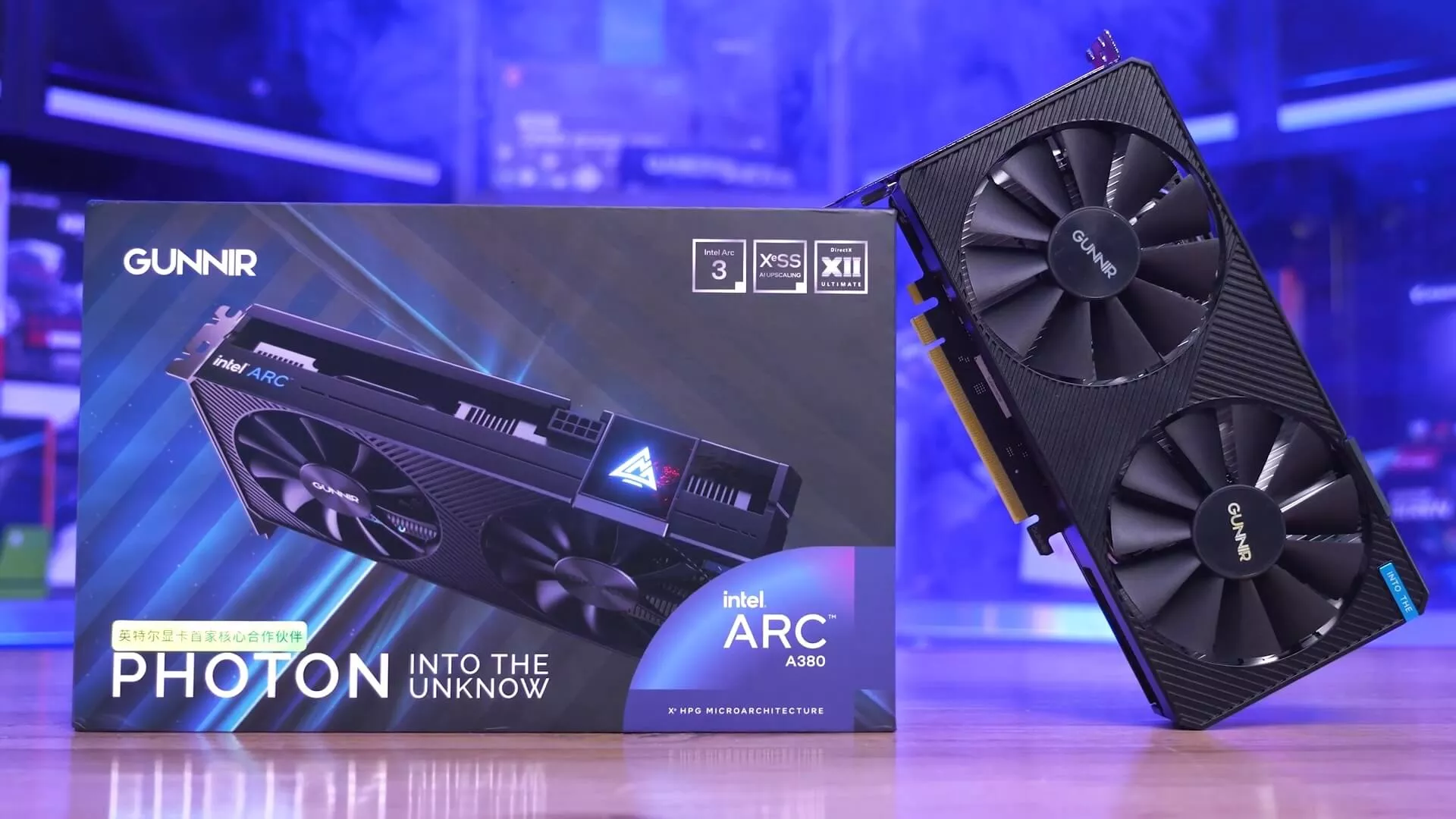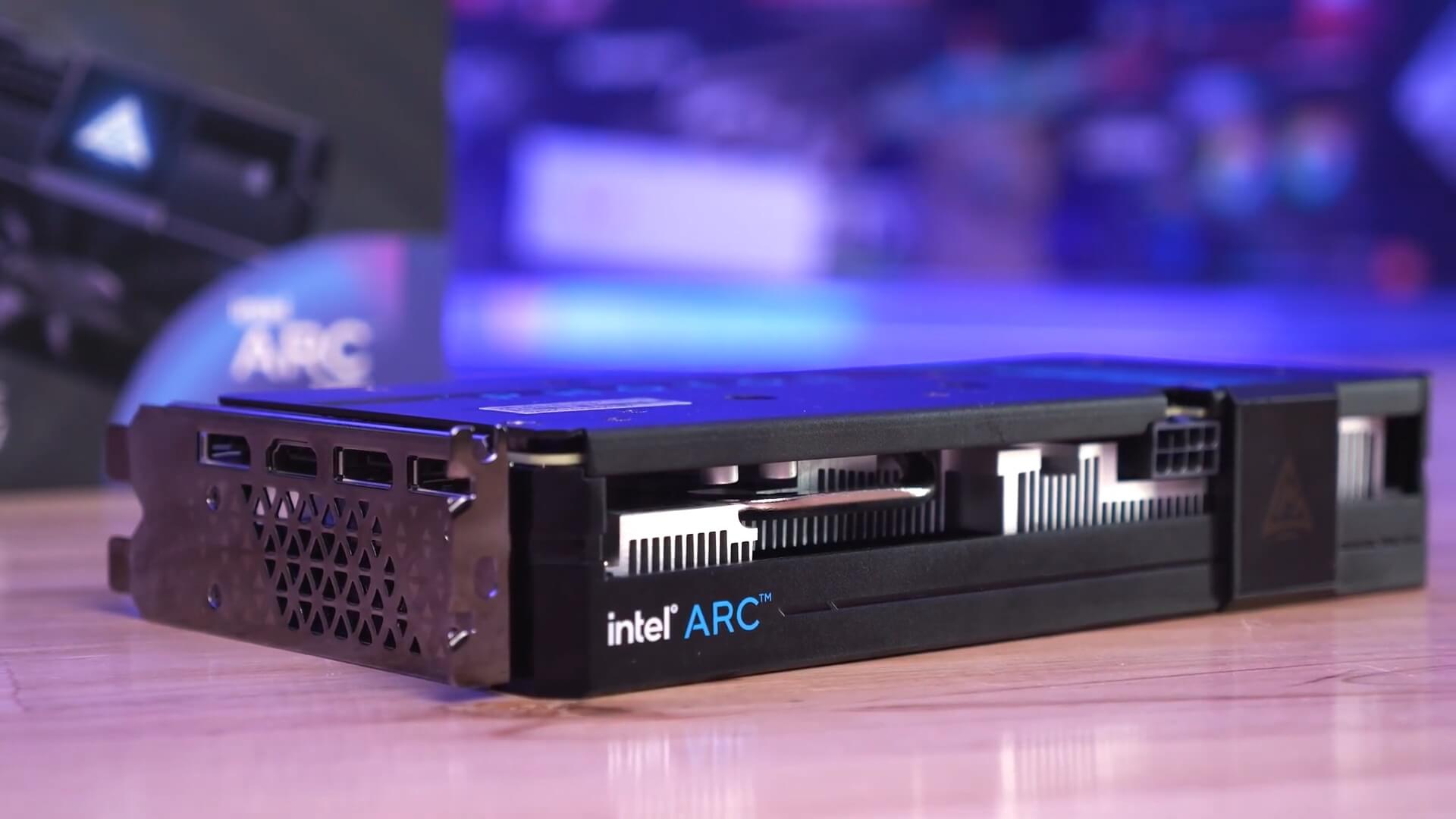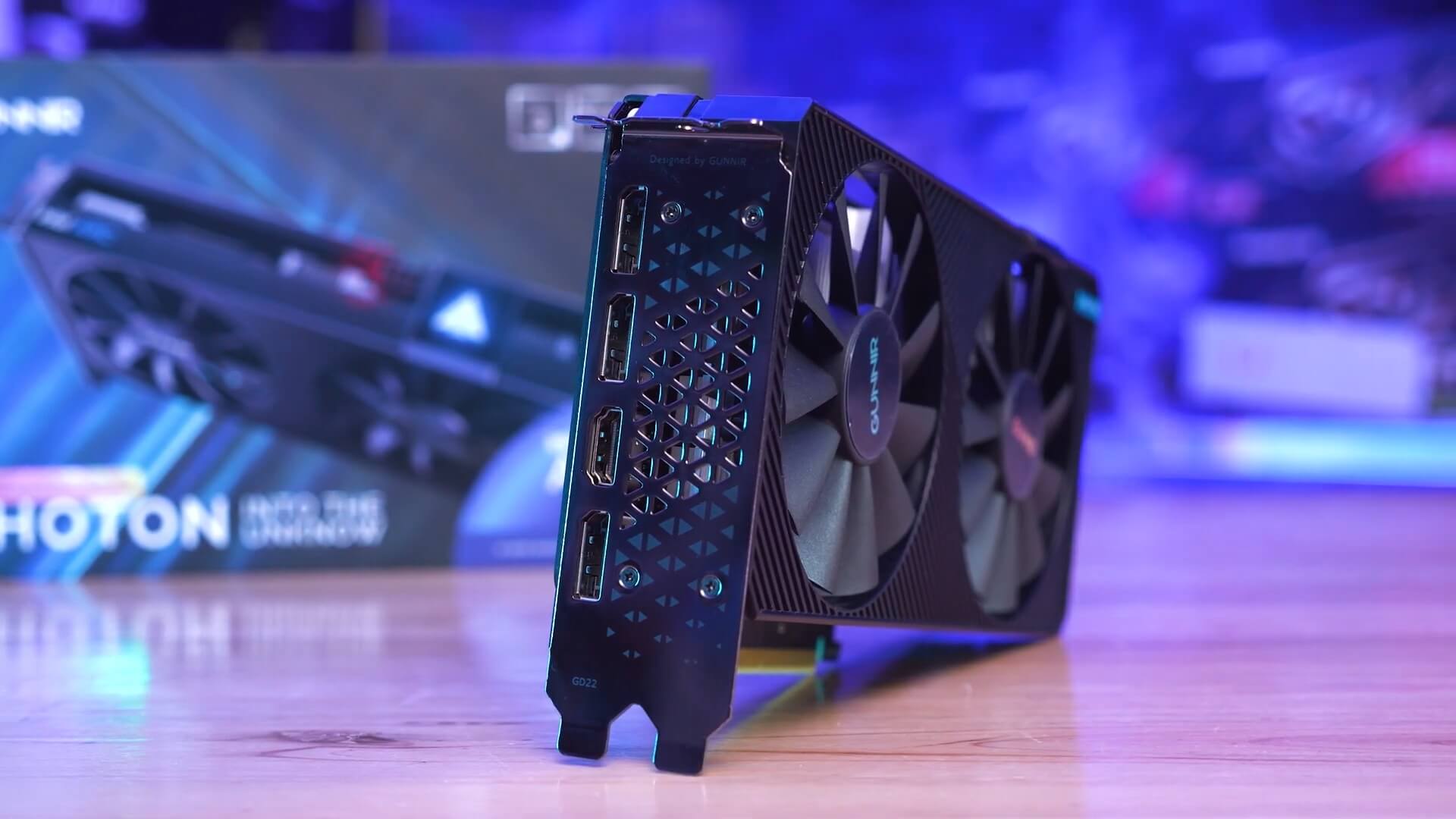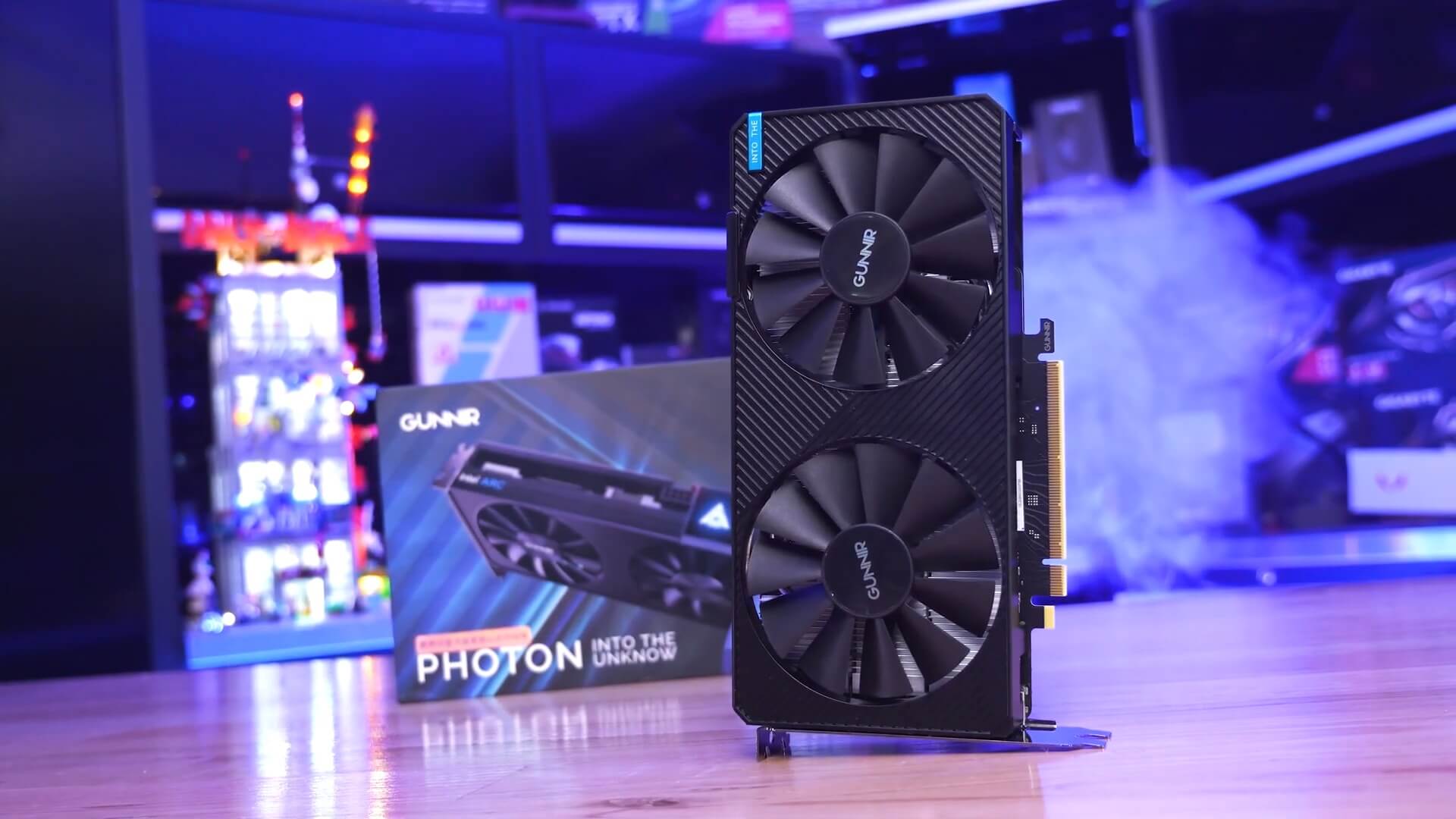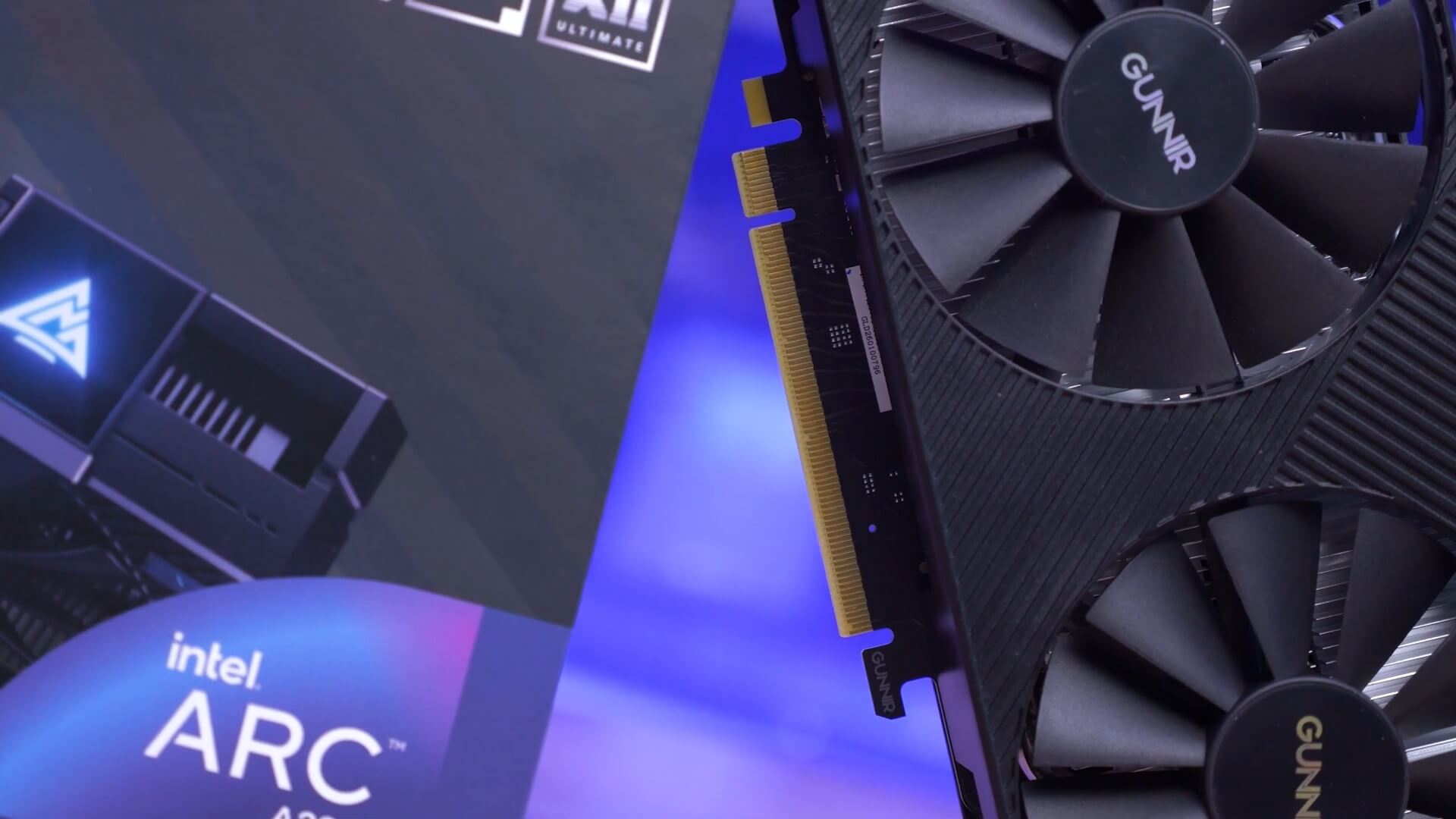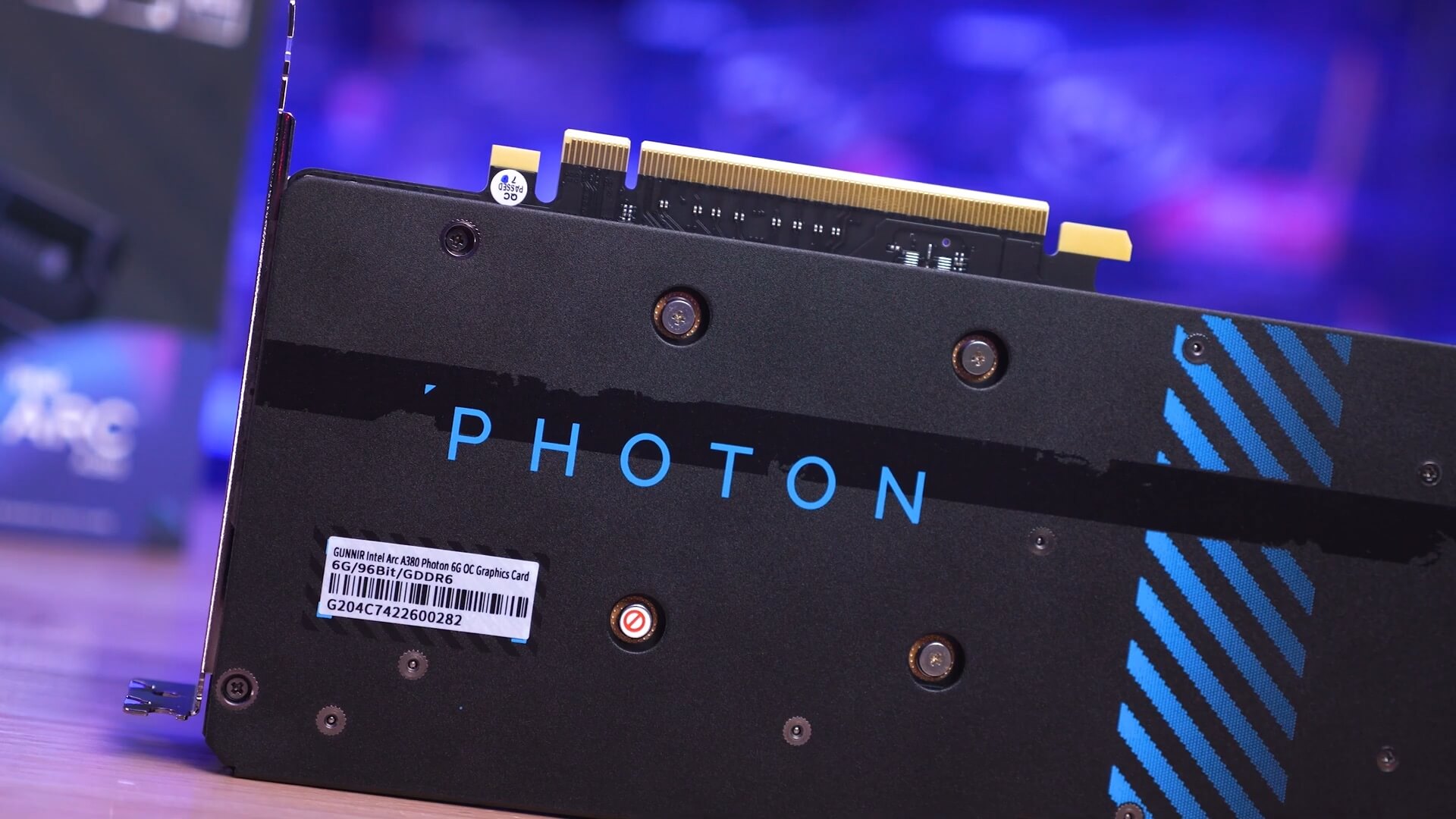After much anticipation, we’re finally getting our first look at Intel’s first generation discrete GPU, the Arc 3 A380. This will be Intel’s most entry-level offering in the Alchemist lineup, expected to cost somewhere between $120 to $130, which will make it the most affordable new graphics card on the market today.
Now, this is still an unofficial review in the sense that Intel’s yet to begin their review program for the new Arc GPUs codenamed ‘Alchemist’, or even release them outside of China. We purchased this graphics card for way, way too much from an eBay seller in China, but despite that we appreciate being able to get our hands on one early.
Like everyone else who has managed to get their hands on an A380 graphics card, ours is the Gunnir Photon model, which looks to be rather well put together, but as you can imagine our focus today will be on the A380 GPU first and foremost.
Based on TSMC’s N6 process, the DG2-128 die packs 7.2 billion transistors inside a 157mm2 die. The core configuration consists of 1024 cores clocked at up to 2 GHz, 64 TMUs, and 32 ROPs. For the memory, it packs 6GB of 15.5 Gbps DDR6 memory on a 96-bit wide memory bus for a bandwidth of 186 GB/s, comparable to that of the entry-level GeForce GTX 1650 released back in 2019.
In terms of features, all Intel Alchemist GPUs support AV1 fixed-function hardware encoding, DisplayPort 2.0, DirectX 12 Ultimate, hardware-based ray tracing and XeSS — Intel’s version of supersampling based on neural networks — similar to Nvidia’s DLSS. So at least in terms of features these new Arc GPUs will rival the current generation AMD and Nvidia parts. For performance though, that’s a totally different story.
In the past week or so other media outlets have also got their hands on the A380, so if you’ve read some of that you’ll be aware that Intel still has a lot work to do on the driver front, and there are a few quirks such as the need for Resizable BAR support in order to deliver acceptable performance.
With that in mind, our plan is to first cover the A380 with our standard review format and then follow up in the coming days and weeks with more testing to establish baseline performance across a broader range of games. We suspect, and of course hope, that Intel will continue to work on driver optimizations and make improvements over the coming months, so by getting all this data now we can monitor that progress as it happens.
Let’s now get into the benchmark phase. For testing we’re using our Ryzen 9 5950X GPU test system. We know no one is going to pair a budget graphics card with this CPU, but that’s besides the point. In order to test GPU performance we wish to avoid introducing a CPU bottleneck which would skew the data.
For our low-end to entry-level GPU testing we typically use medium quality settings, or settings that make sense for a given title. The Intel A380 was tested with and without Resizable BAR whereas all other GPUs have been tested with ReBAR disabled, but this is something we’ll update in the future.
Games were tested at 1080p and 1440p resolutions although it makes more sense to focus on the more relevant 1080p results, as you will see in a second. Let’s get into it.
Benchmarks
Starting with Assassin’s Creed Valhalla, we find that Intel’s A380 isn’t the snappiest of GPUs, 48 fps at 1080p using the medium quality preset, which is better than the old GeForce GTX 1050 Ti, but 11% slower than the Radeon RX 6400 when that part is afforded a PCIe 4.0 interface. Probably more disappointing is that it’s 9% slower than the RX 570, a now 5-year-old graphics card that started life at just $170.
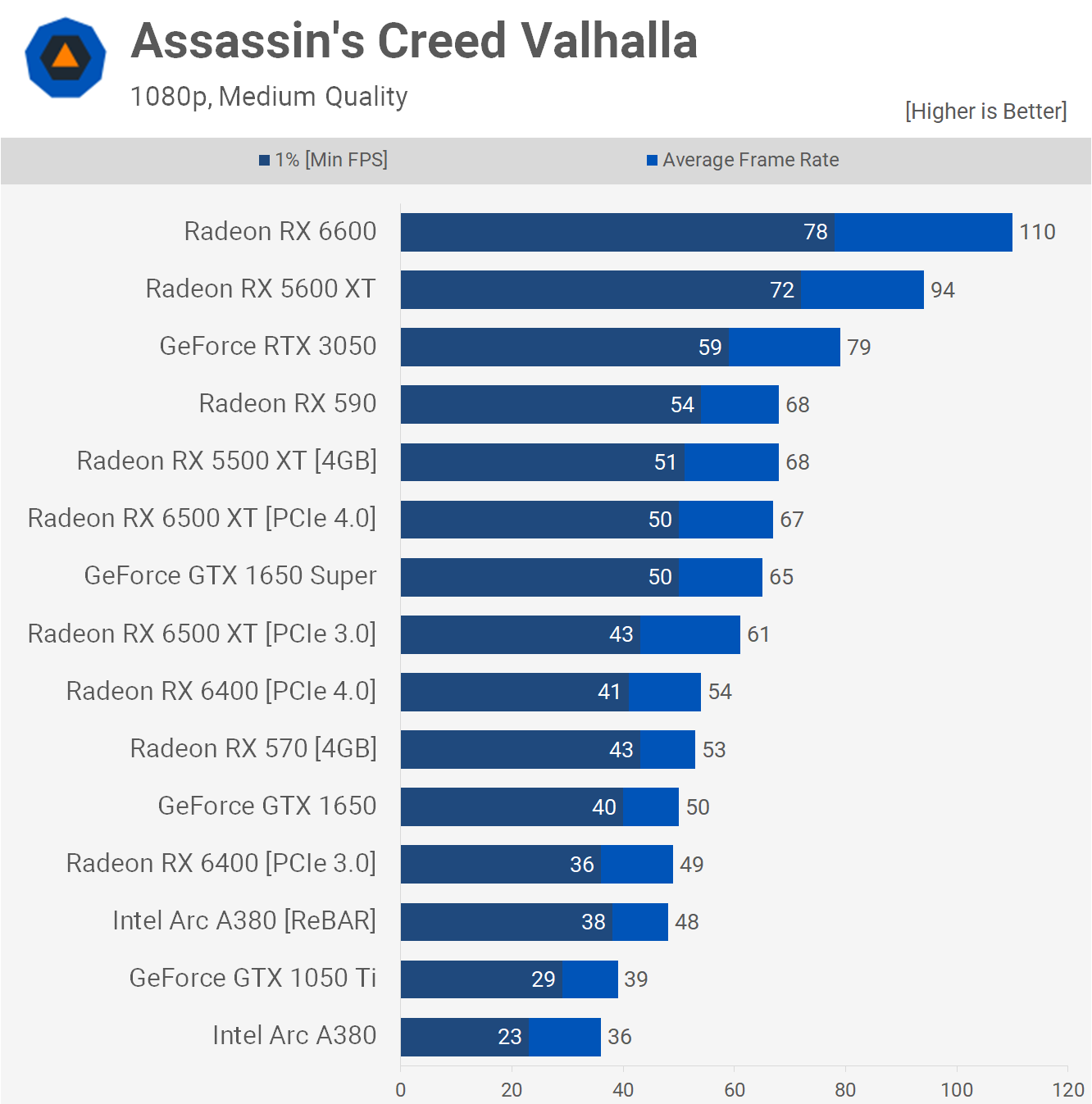
Still, the game was playable, so we guess there’s that. It should be noted you absolutely need ReBAR enabled, as Intel recommends, otherwise you’ll be limited to just 36 fps on average with weaker and frankly unplayable 1% lows of 23 fps.
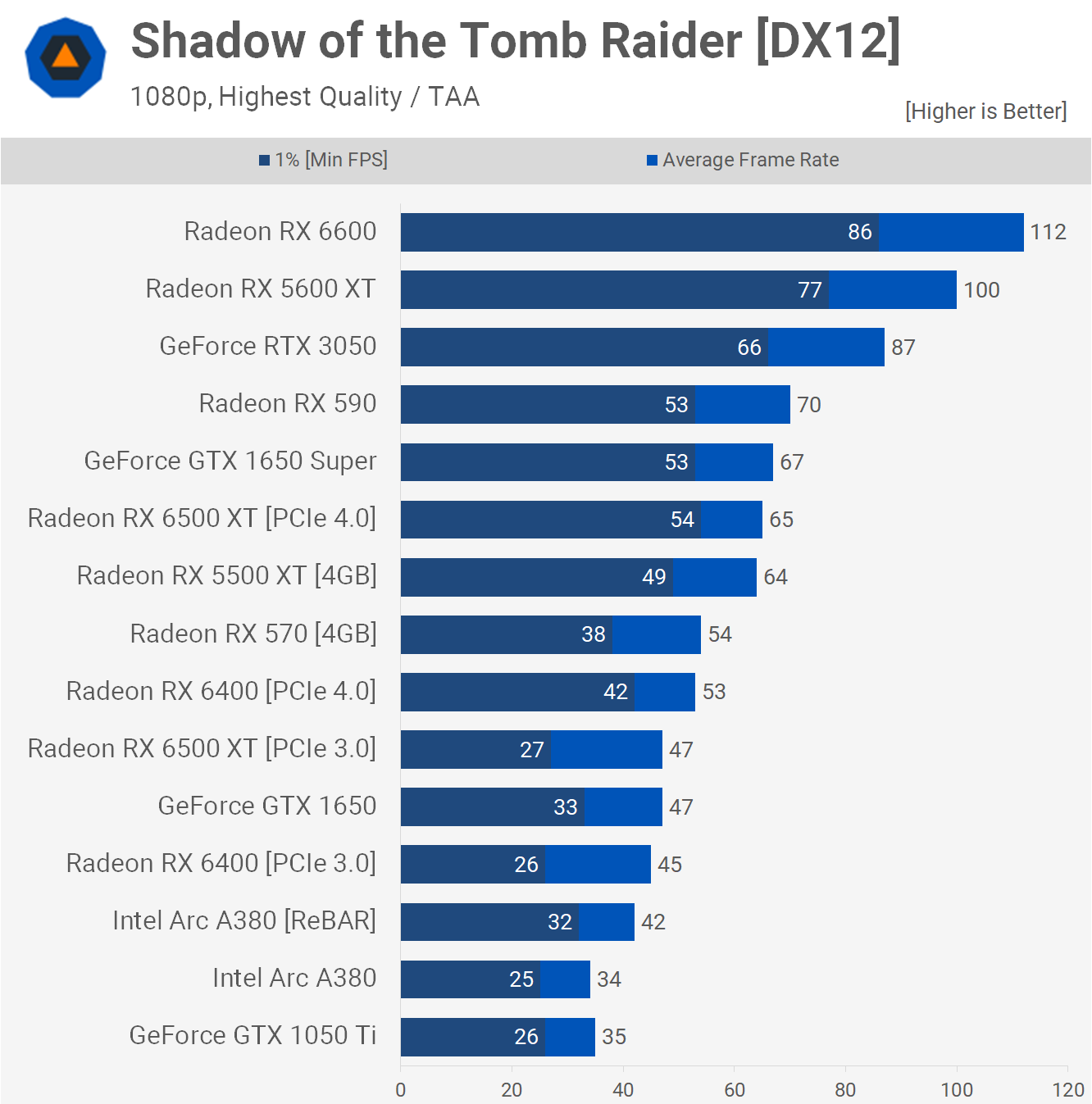
Next we have Shadow of the Tomb Raider with downright horrible performance at 42 fps on average at 1080p, and although we are using the highest quality settings, the old Radeon RX 570 was good for 54 fps and the Radeon RX 6400 53 fps.
If we limit the RX 6400 to PCIe 3.0 bandwidth, it is comparable with the A380. Again you’ll want to make sure ReBAR can be enabled, because without it the game is not playable in these conditions.

Moving on to Watch Dogs: Legion, the results are more promising, though we’re still only looking at Radeon RX 570 or RX 6400-like performance. But 59 fps on average with the medium quality preset is very playable and it’s certainly competitive with the Radeon RX 6400. Without ReBAR, the A380 slows down and quickly becomes a GTX 1050 Ti-like GPU.

In Rainbow Six Siege performance is reasonable relative to the competition. In fact, it’s a bit better than that, matching the Radeon RX 6500 XT… and 1% lows were quite a bit better in fact.
It’s still not quite up there to compete with the GTX 1650 or RX 570, but 114 fps on average using ultra quality settings is a good result, and far better than the Radeon RX 6400. As shown above, without ReBAR performance drops as much as 26%.

With F1 2021, the Arc A380 is back to delivering RX 6400-like performance, which considering the expected price is decent, and the performance overall very playable using high quality settings. Of course, once again ReBAR is mandatory and without it this game was unplayable with 1% lows of just 22 fps.

In Horizon Zero Dawn we’re looking at Radeon RX 570 and RX 6400-like performance, at about 50 fps on average. Not horrible, and as we’ve found over and over, ReBAR will be required as without it the A380 is slower than even the GTX 1050 Ti.
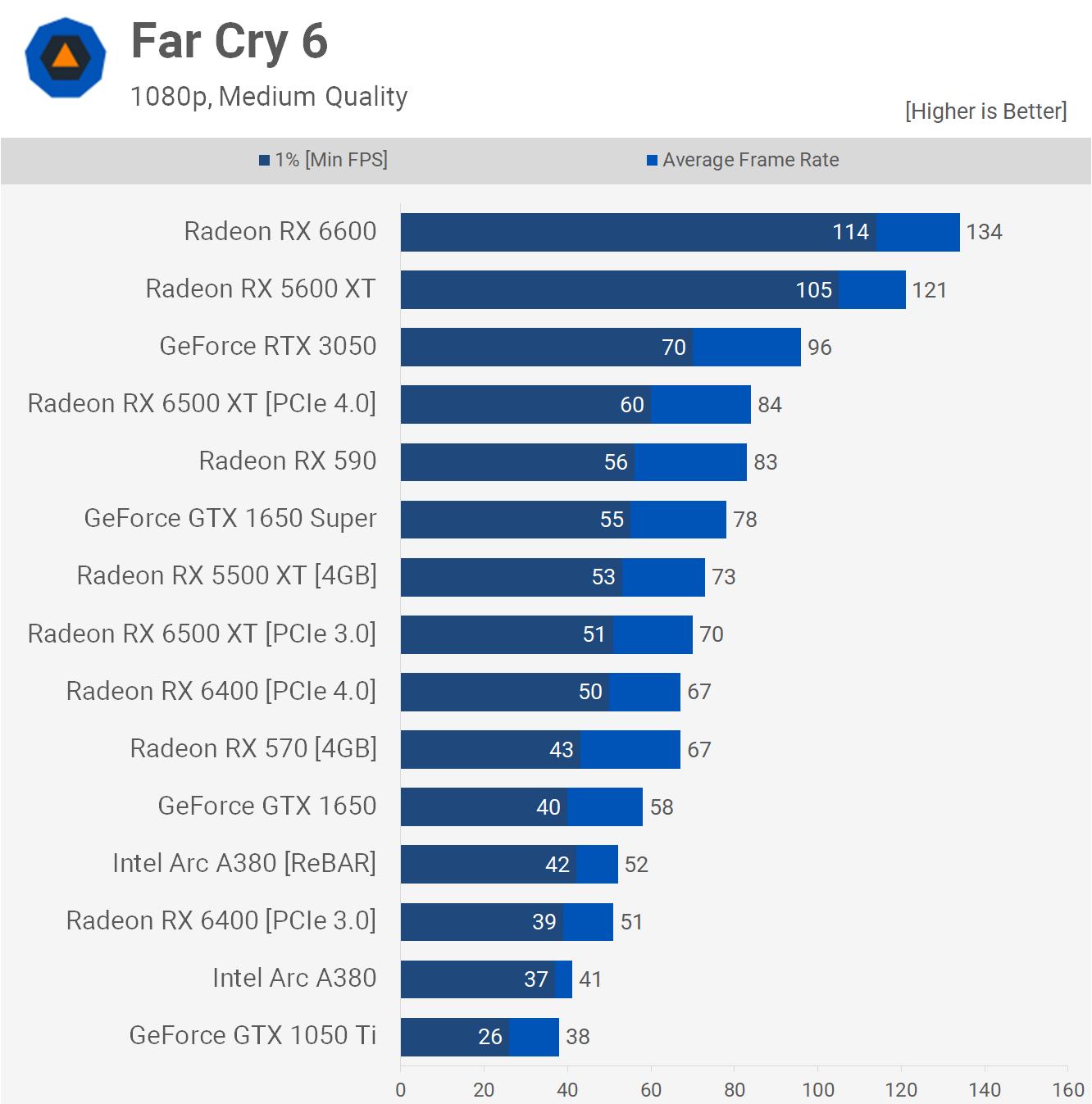
Performance in Far Cry 6 is lackluster, just 52 fps on average which is less than that of the GeForce GTX 1650 and on par with the Radeon RX 6400 when limited to PCIe 3.0, but 22% slower than the 6400 using PCIe 4.0, and 22% slower than the old RX 570, so that’s not good.

Moving on, Doom Eternal performance was reasonable, 56 fps at 1080p using the ultra quality preset which is an 8% increase over the Radeon RX 6400, and 10% slower than the RX 570. The game is playable though, so that’s a positive for the A380, and about where we’re setting the bar at this point.

Frame rates in Resident Evil Village were also reasonable, 68 fps on average meant the A380 was slightly faster than the GTX 1650, but once again slower than the much older RX 570.
With ReBAR disabled the average frame rate still looks reasonable, normally 58 fps would be very playable, but the 1% lows were horrible, leading to a stuttery gaming experience.

Death Stranding results are more concerning as the A380 is 13% slower than the Radeon RX 6400 and 15% slower than the RX 570, while matching the already underwhelming GTX 1650.
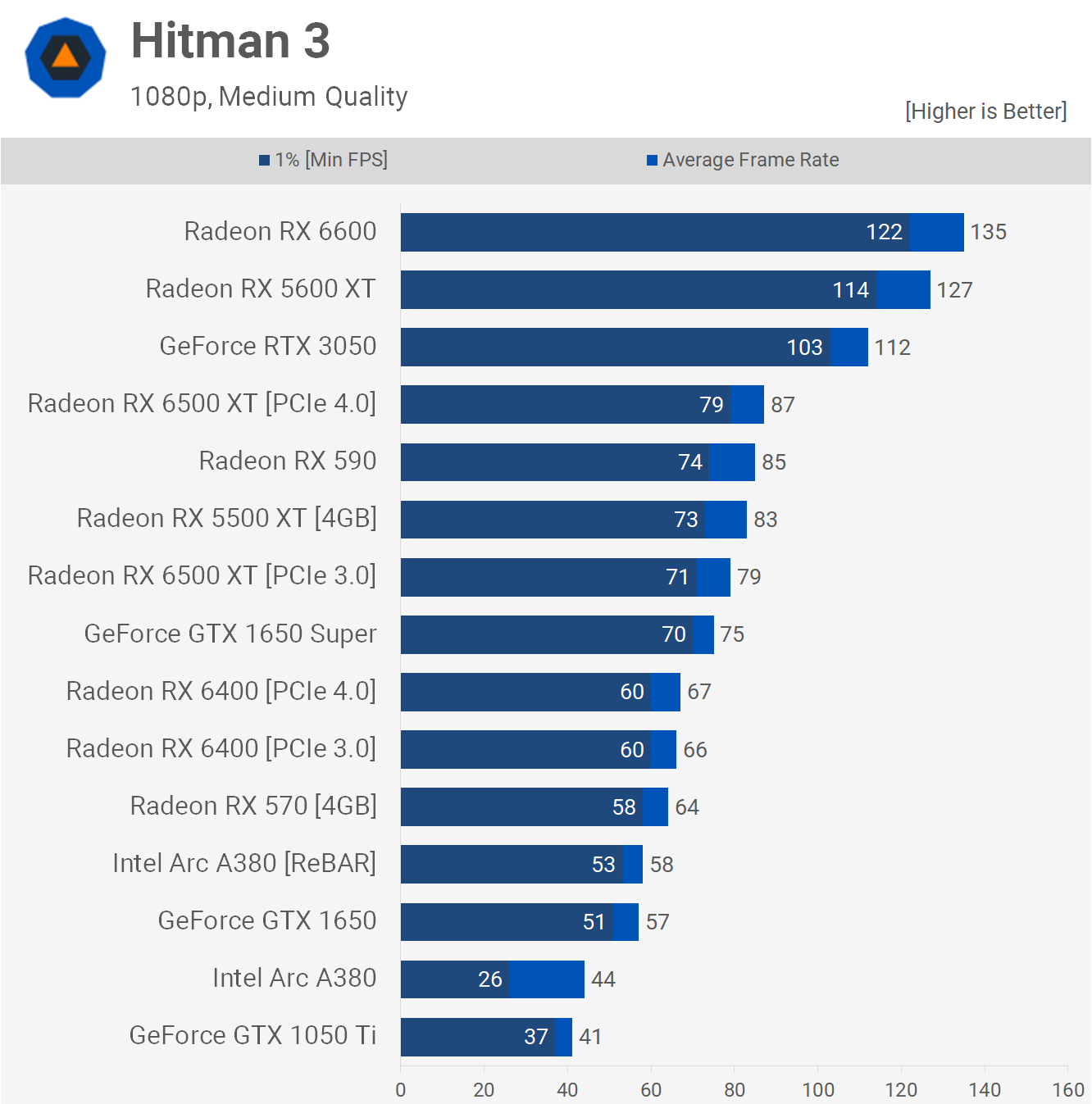
Hitman 3 is another rough title for the Arc A380 which only sees GTX 1650-like performance, making it slower than both the Radeon RX 570 and RX 6400.
Of course, 58 fps on average with 1% lows of 53 fps is playable, so there’s that, but without ReBAR the 1% lows dropped to 26 fps.

We were shocked to see the A380 doing well in Cyberpunk relative to parts such as the Radeon 6400 and RX 570, both of which get beat by a 16% margin (when ReBAR is enabled). Sadly, 44 fps on average at 1080p using the medium quality preset is at best a suboptimal gaming experience, but relative to other budget graphics cards it’s a pass.
Power Consumption
The Intel Arc A380 is reasonably light on power usage, yet it’s not quite where it needs to be. Total system usage was pushed up to 233 watts, or slightly higher than the GTX 1650 Super, a GPU that was on average a bit over 40% faster in our testing.

Ideally, the A380 would sit below the RX 6400, but in reality for most gamers the difference won’t matter as the Arc graphics card will work just fine with low-end budget power supplies.
Cooling
For looking at cooling performance we recorded gameplay with the on-screen display using the Intel graphics command center, so the A380 was used for video encoding. Admittedly, we’ve yet to play around with this properly but we were unable to record gameplay without choppy playback, the game itself ran much smoother than the recording.
But for the purpose of recording operating statistics it worked, so we’ll use it. When gaming the Gunnir Photon A380 peaked at just 60C with a fan speed of no more than 1600 RPM, making it a very cool and quiet graphics card, and that’s a positive.
The GPU typically clocked at 2.4 GHz and the memory operated at the advertised 15.5 Gbps. Overall a good quality graphics card.
12 Game Average
Looking at the full performance breakdown, as expected the results aren’t great. The Intel Arc A380 is at best able to match the Radeon RX 6400 and the old GTX 1650, making it on average 11% slower than the old RX 570 and way slower than the 5500 XT, which shares a similar size die.

We hated the performance we received from the Radeon RX 6400, so we can’t say we’re impressed with the Arc A380.
Pros and Cons
It’s early days for Intel’s Alchemist architecture, and the entry-level Arc A380 is technically unreleased, but to say the situation for Intel is concerning right now would be a massive understatement.
We could always assume that driver optimization would be the Achilles’ heel of any Intel discrete GPU venture upon arrival, and perhaps that’s all we’re looking at here, a lack of driver development that could improve over the coming months and years. Frankly though, that’s probably a best-case scenario as more recently it’s been suggested that Intel’s been stalling the release of their Arc series due to fundamental hardware issues that can’t be resolved by drivers alone. Of course, at this point this is just a rumor, but the expected rough start has been just that.
Moreover, the rumor mill has been running hot regarding Intel Arc as of late, with many suggesting that the chip giant is seriously considering cancelling the entire project, allegedly considering it too expensive with no clear road to profitability.
Frankly, it would be extremely disappointing if Intel didn’t push forward. Intel’s first generation of discrete GPUs was never going to be profitable, the execution was never going to be flawless or even smooth, and it was always going to take 3 or 4 generations before they started to get on their feet. We’d assumed Intel knew this and had budgeted for it, but we’ll soon see if this goes one way or the other.
Rumors aside, the Arc A380 is disappointing as a first foray, but we don’t think it’s a lost cause assuming further driver development can pretty up the picture a bit. Granted, it’s a complete mess without Resizable Bar, which kind of goes to show drivers are immature, but for now we’d like to think of Arc as a forward-thinking investment.
Intel did say that support for older games wouldn’t be great. The focus is on new titles using modern APIs like DX12 and Vulkan. Clearly, they’re also focusing on newer PC hardware. The A380 would be a horrible pairing for an older PC that doesn’t support ReBAR, which right now is a must-have for this Arc GPU.
In its current condition, we wouldn’t recommend you to buy an Intel Arc GPU, but the question of whether or not you should buy one when they’re eventually released, can’t be definitely answered just yet.
There’s also the matter of pricing. Assuming the rumors are all wrong and we forget everything we just said, meaning Intel is 100% committed to Arc… if the A380 were to hit shelves for around $120, which is about $50 less than that of the Radeon RX 6400, should you buy it?
If the only alternative was the RX 6400, I could kind of see myself gambling on the A380, mostly because I don’t care for playing older games anymore, you also get hardware encoding, though that could do with some software development, you get more than 2 display outputs, and AV1 decoding. Also the extra 2GB of VRAM come handy and the PCIe x16 interface should help avoid performance related issues when maxing out the VRAM buffer.
But for gamers on a tight budget, neither the A380 nor RX 6400 would make my recommendation anyway. Instead we’d suggest checking out your local used market. For example, Radeon RX 570’s regularly sell on eBay for around $100, while GTX 1650 Super’s go for ~$150 and both are faster than either the RX 6400 or A380.
Intel has a lot of work ahead of them and we sincerely hope they can eventually position themselves as a legitimate third competitor in the discrete GPU market, but for now that’s not looking particularly promising.


